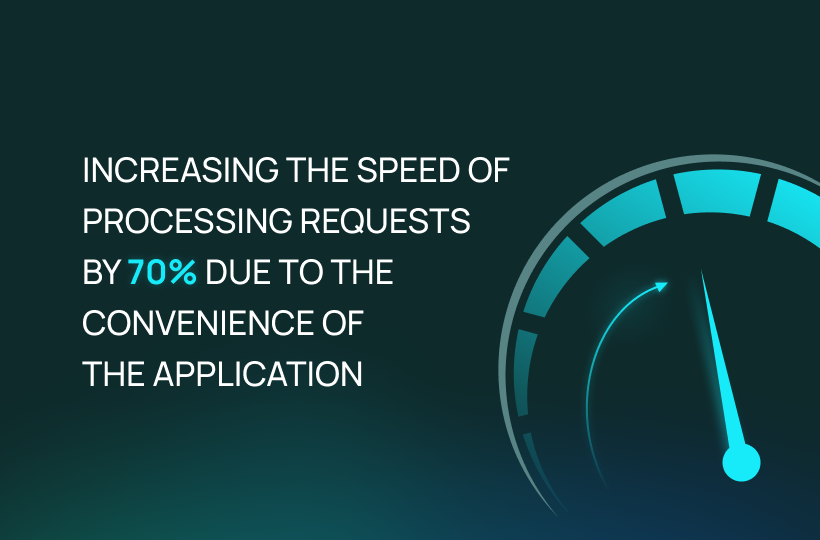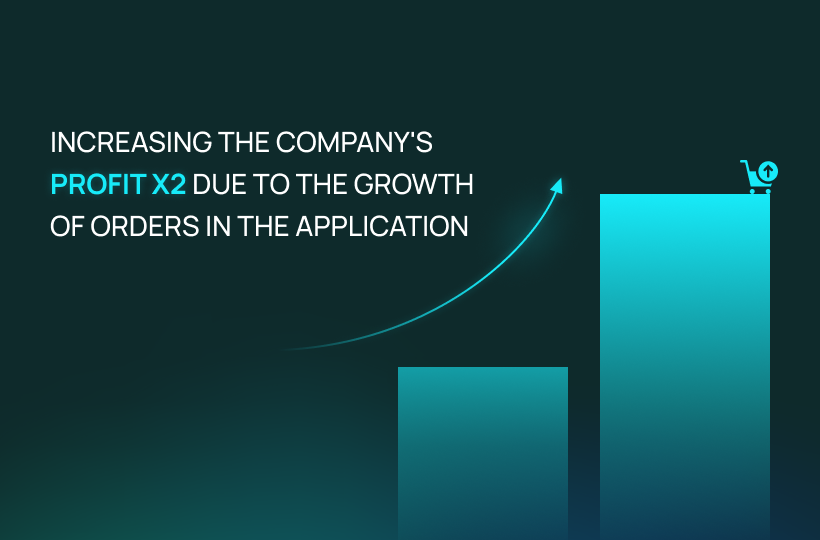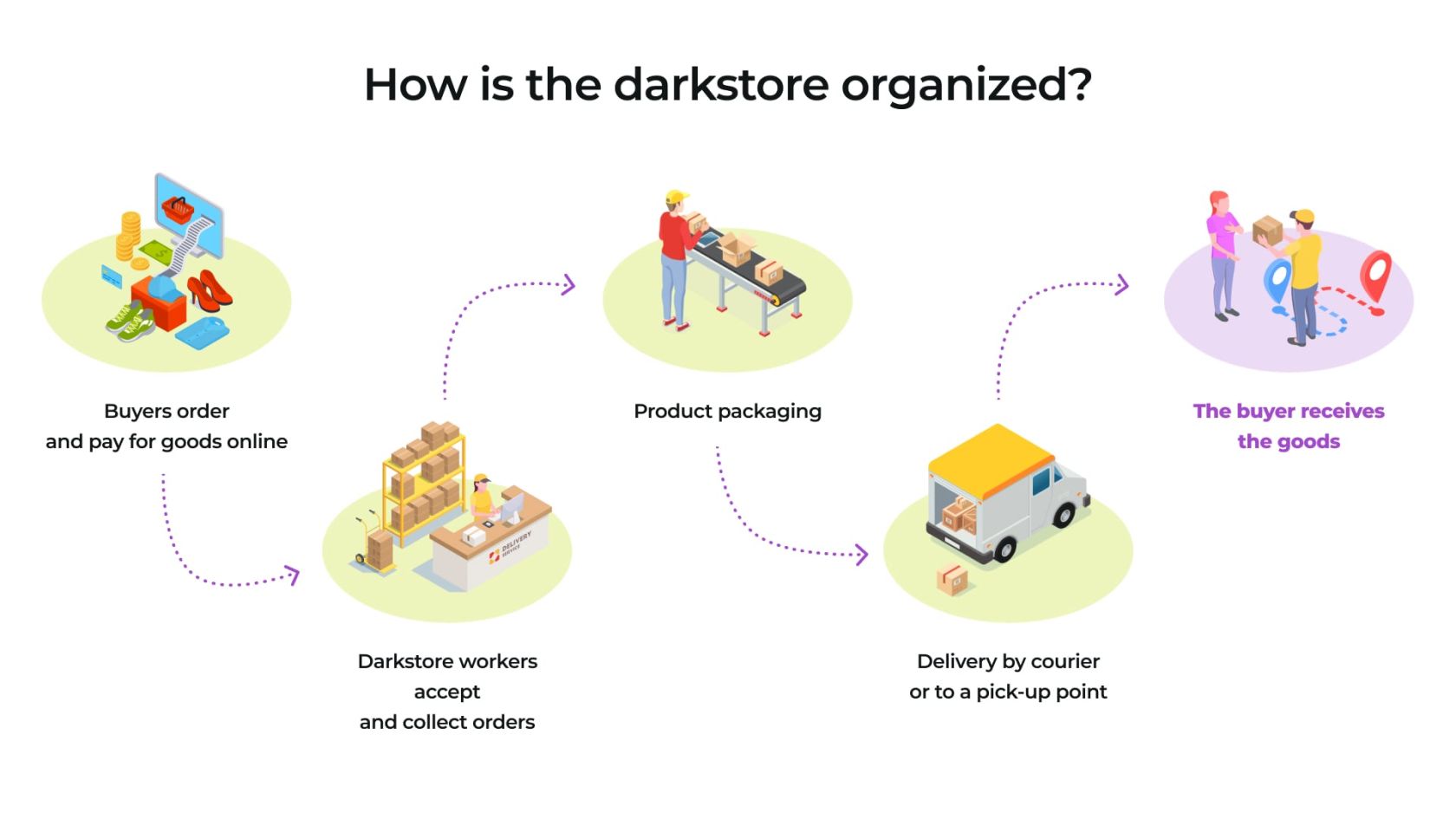In today's rapidly evolving retail landscape, old methods are making way for new, more efficient ones. One such innovative concept is the DarkStore – a digital convenience store that operates without sales halls, queues, and salespeople. In this article, we recount our journey of creating a DarkStore in a record time of three months for a leading FMCG retail chain, detailing the challenges we faced and the solutions we implemented.
A few words about darkstores
Traditional supermarkets and shopping malls have long been integral to our consumer culture. However, the evolution of technology and changing consumer behavior have prompted the emergence of new retail formats. Among them, the concept of the DarkStore stands out – an online platform that merges the convenience of an online store with the speed of a food delivery service.
Initially conceptualized by British retailer Tesco in 2009, the DarkStore format has recently experienced a resurgence. Factors like widespread smartphone adoption and the changes brought about by the COVID-19 pandemic have made it a more relevant and viable model than ever before.
But then the idea was 10 years ahead of its time, and the niche of such stores was still small. Recently, the format has been reborn – the general availability of smartphones and the pandemic have made it more relevant than ever. Similar startups are now growing rapidly in the UK (Jiffy), Germany (Gorillas) and and other countries around the world.
How we started creating adarkstore
In late 2021, we received a request from OnePrice, a successful retail chain with a network of over a hundred FMCG stores across the country. Their ambitious goal was to pioneer a mass-market DarkStore for everyday essential products, a concept that had been attempted but not fully realized in the past.
However, the client was not going to stop there and set an ambitious goal – to create first mass darkstore with products of daily demand. Attempts to launch such services had been made before, but they always miss something to become a trend.
The client considered 2022 as a turning point in retail when the business would start a startup race during the post-crisis economic recovery. He needed a new darkstore platform as soon as possible. We are not just talking about an online store, but about a service with the shortest purchase cycle and super-fast delivery.
The key point: the customer must receive his order by courier in 15 minutes. This can be achieved through the creation of an extensive network of small warehouse stores in the city limits, which overlap almost any delivery address. Such a system requires well-functioning logistics and a powerful digital ecosystem.
The project concept was detailed quickly: it required a website and a mobile application for e-commerce, as well as an application for couriers. These products had to be combined through a single DarkStore Backend and integrated with digital retail tools: 1C accounting, a customer management system (CRM) and a warehouse management platform (WMS).
How the technology was chosen
Although the format of the service is innovative, technically DarkStore development does not require anything complicated. All solutions for creating darkstores have been used in e-commerce one way or another for a long time, you just need to put them all together.
- The site was developed through classic layout: HTML, CSS, native JavaScript.
- The cross-platform mobile apps were made in Flutter, using BLoC, Hive and Dart.
- The backend is written in PHP 8.1 (Laravel + Octane), PosgreSQL and Redis are used for database management.
All these tools are familiar to our developers, including from experience working on products for e-commerce. This allowed us to speed up the development process many times over.

How communication was managed
This does not mean, however, that the team had nothing to do. On the contrary, deadlines were very tight, and the team decided to abandon the usual practice of working in sprints.
Breaking a three-month project into sprints did not make sense, and instead, we formed a common task board that needed to be distributed among specialists. And then we moved from stage to stage: drawing and design approval for each individual product, technical development, creating presentations, and managing quality control.
Such development required constant, daily communication between the team and the client. For efficiency and responsiveness the team constantly had to clarify something: to address issues on the integration of 1C and CRM, request access to resources and documents, to find out the details of the business logic. While developing, the WEZOM team and the product manager on the client side became one team. And this connection was maintained even after the war began, although not without difficulties.
Development Challenges
Despite our expertise in e-commerce technologies, we faced several challenges along the way. The development of new modules, API integration, and working with third-party tools proved more complex than initially anticipated. Particularly, mobile development, which plays a central role in the DarkStore ecosystem, presented numerous challenges.
The biggest challenge was mobile development. The mobile app plays a central role in the dark store ecosystem, since the overwhelming majority of users will be using the service from their smartphones. The platform had to implement a complex ordering chain with various scenarios, and consider numerous interconnections with the company's tools and databases. Integration of the API for Google Maps also caused certain difficulties, which required serious work on geolocation.
What do we have now
Despite the technical difficulties and the war, the development as a whole managed to meet the declared deadline. Due to obvious circumstances, the project has been put on pause, and its release is delayed for the future.
Nevertheless, as of today, NeoShop is technically ready for release. It consists of three products:
- DarkStore website
- A mobile app for customers (DarkStore app)
- Courier app (DarkStore courier app)
Let's take a closer look at each of them.
NeoShop site successfully combines the capabilities of an online store and a corporate portal. On its pages, customers can view the product catalogue, form their cart and place an order and specify the delivery address. Availability of goods is tied to a specific darkstore with a specific delivery zone. In turn, couriers can get employment information on the site and apply for an interview. There is also a separate page for suppliers and distributors wishing to cooperate with the store.
The NeoShop app is a good example of a modern DarkStore mobile service. In a nutshell, it provides the same features as the website, but also notifications. The experience of using the app is something between a classic online store and a food delivery service. After placing an order, the user can monitor the status of his order in real-time: from processing and assembly to final delivery.

Delivery courier app is a simple and effective delivery tool that any employee can quickly learn without any problems. The platform gives the courier countless advantages: mapping, mobile notifications, simple accounting, and a personal account with a history of completed orders. The delivery card contains not only the address but also the amount and method of payment. The courier can immediately contact the recipient of the order and clarify the details.
All these products are units of the same chain, they work through a common backend. Third-party tools are also built into this chain: Google Card APIs and payment services, 1C accounting tools, CRM, and warehouse management.
The main objective of NeoShop ecosystem is to simplify users’ way to purchase and ensure that their order is delivered within 15 minutes. The system may look simple, but this impression is deceptive. Many of its functions rely on complex logic, and their implementation has become a real challenge for the team.
For example, each darkstore is a location with its area of coverage from specific streets, which required point markings on the map. It is very likely that the coverage zones will change in practice, so it was important to edit them easily. In addition, each darkstore has its own current assortment, which is important to update in real time. It depends on which products right now can be found in the catalog of an individual user. Finally, darkstores in different cities and locations will differ in terms of opening hours and delivery costs, and the app needs to adequately present this logic.
The speedy delivery system needs incredible flexibility, which conventional online stores can only dream of. And this flexibility had to be invented right during the creating process.
Today, the Сlient managed to get the following profit:

Why are darkstores influential?
Of course, traditional retail with physical stores is not going to disappear. After all, it is important for brands to attract attention and ensure their offline presence, and customers appreciate the opportunity to see offline the goods they are interested in, and often consider shopping as a weekend pastime.
However, all this is more relevant for non-food retail (clothes, electronics, etc.) and to a lesser extent for everyday goods. If we are talking about a weekday trip to the store for vegetables for the soup, people are less willing to spend time on it. And that makes the darkstore format a very promising model. In addition, it has more powerful advantages:
- Resilience to social upheaval. The experience of the past three years has shown that the emphasis on business online provides him a good margin of safety in any situation. Physical stores can close because of another pandemic, or military threats. But online delivery in such situations continues to work as long as it is possible to provide its logistics.
- Reduced costs. A traditional supermarket requires renting a spacious space in a busy location, as well as equipment for the sales floor and merchandising. In contrast to supermarkets, darkstores can be equipped in compact and unpresentable warehouses (DarkStore warehouse) as there will be no customers, no guards, and cashiers. Even the electricity bill will be lower. This is an obvious opportunity to save money.
- Smart stock control. Darkstore vitally needs real-time visibility into each warehouse's product inventory; without it, it's difficult to ensure the adequacy of the assortment in the application and the speed of delivery. But it also helps the retailer dispose of products more rationally – to increase inventory turnover, and reduce losses among stock balances. This is especially relevant in FMCG, where goods have a limited shelf life.
- Simplicity of management. Traditional supermarket requires a large staff. At the same time, sales staff work in a stressful mode, sometimes torn between the layout of goods, control of the queue, and questions of individual customers, which is detrimental to service. At the same time, darkstore requires only an operator, a picker, and a few sorters of goods, who will not be distracted by customers. This avoids additional costs and makes much more efficient use of employees' time.
The global economic crisis has slowed down the development of retail, but it certainly hasn't stopped it. As the market revives, the online delivery market will grow rapidly, and we will see a number of such startups in the coming years. So, retailers should prepare for market transformation now. At least, they should study the DarkStore software market and raise the standards of their own online delivery. And as a maximum, they should search for partners or specialists for their own darkstore network of the future.





